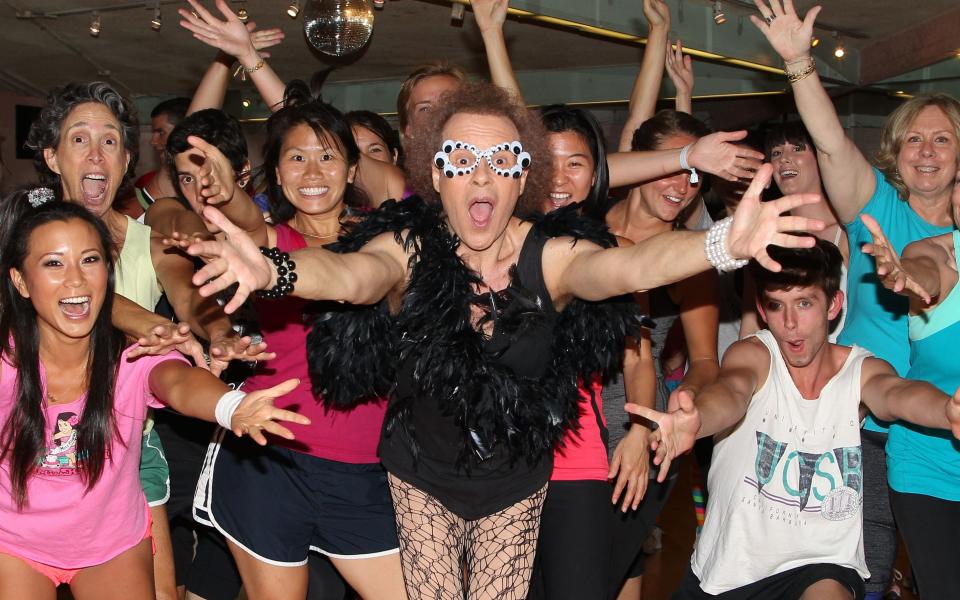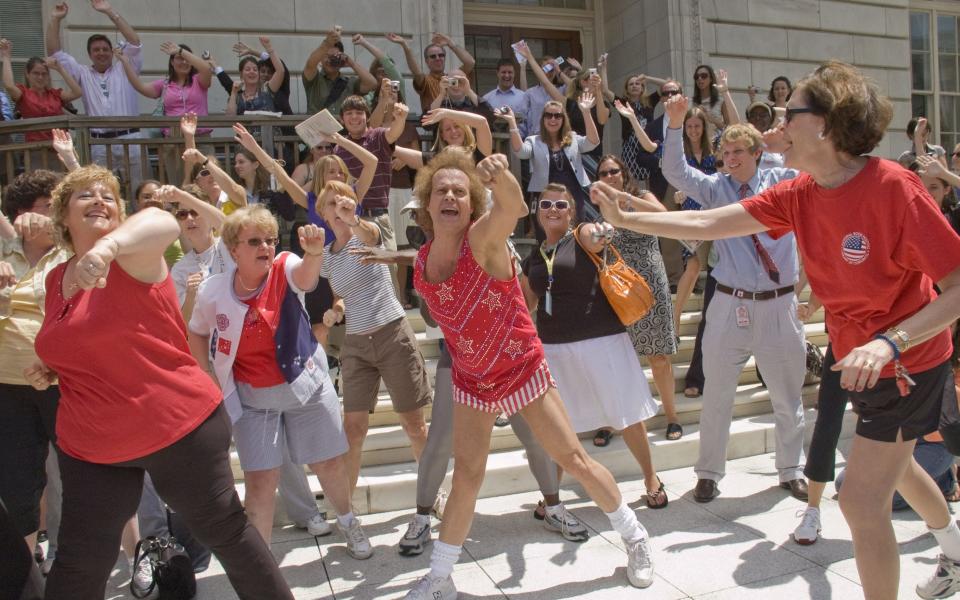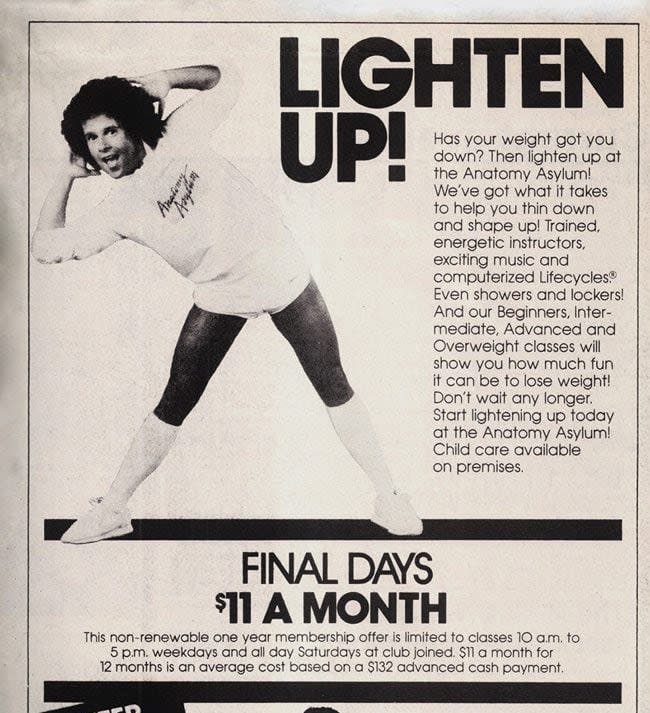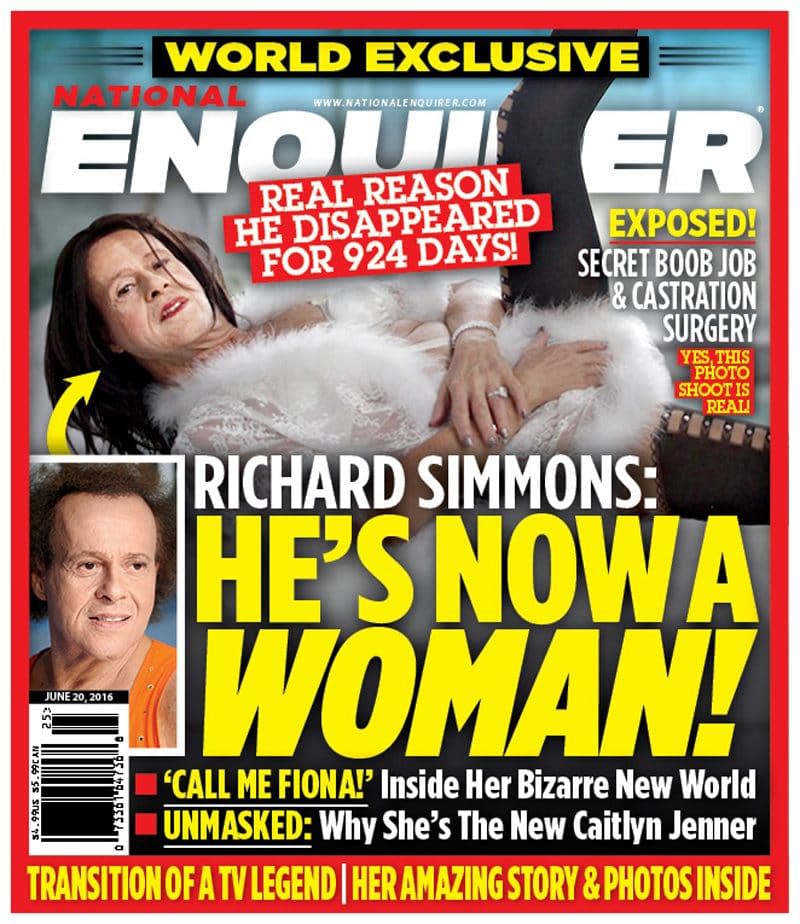Who is Richard Simmons, and why did he go missing? The bizarre true story behind a podcast sensation

“I am a cryer. I have always been. When rain pours down from the heavens, angels are crying. I cry tears of joy and sometimes, tears of sadness. After all tears, comes a rainbow.”
Imagine those words, those heartfelt words, coming from a man in tiny shorts and a bedazzled tank top. A man with a dandelion of frizzy hair and a personality that can vault in the space of a sentence from weepy vulnerability to shrieking, swinging-from-the-chandeliers hysteria. Now make that man a multi-millionaire.
Make him both a pop-culture punchline and the difference between life and death for a significant portion of America. Make him a lifelong bachelor who clams up when questioned about his sexuality, but who will coo, “You look so handsome today I can hardly resist crawling over this desk,” to a stuffed shirt Fox News anchor. That man is the US diet and fitness industry’s pre-eminent pantomime dame, Richard Simmons.
After almost 40 years in the public eye, Simmons, 68, failed to show up to teach a class at his Beverly Hills fitness studio, Slimmons. That was on February 15, 2014. He has not been seen since. And now Missing Richard Simmons, a limited-run podcast dedicated to digging up the truth behind the disappearance, has stirred up Serial-level fascination with his story among people who had barely heard of Simmons until recently.

Why has the plight of such a polarising figure — a cringe-inducing clown to some, a nakedly emotional saviour to others — struck such an immediate chord? Maybe because a lot of America looks at Richard Simmons and sees itself.
You don’t need to be a board-certified therapist to connect Simmons’s emotional volatility and desperate need for connection to an unhappy childhood. Young Milton Teagle Simmons was asthmatic and, for most of high school career in New Orleans, tipped the scales at 268 pounds.
“I took desperate measures to lose weight and did terrible things to myself,” he recalled.”I went from diet pills to 30 laxatives a day to throwing up. Bulimic, anorexic, you name it. And after all the the throwing up, I would starve myself.”
Simmons managed to summon up enough self-discipline through diet and exercise to lose 100 lbs. Having salvaged his own health, he became evangelical about saving others who were still trapped in the binge-and-purge spiral that once claimed him victim. in 1973, he opened the first of what would become a chain of fitness studios he named The Anatomy Asylum.
But there were hundreds of thousands of gyms and even more impassioned instructors. It wasn’t until the early 1980s that America was really ready to listen to what Richard Simmons screech at them.
In 1981 and 1982, two seismic events reshaped the USA. Olivia Newton-John’s Physical video and Jane Fonda’s workout VHS tape were more than mere phenomena. They were life-altering. Going to the gym was once regarded as a chore, but the combination of Newton-John and Fonda’s aerobic propaganda made it a destination.
Fueled by Physical and Fonda, a billion-dollar fitness industry sweated and strained to put a running track and a stationary bike in every American home and outfitted a generation of women in tights, leg-warmers and head-bands. It explicitly reinforced the connection between physical fitness and sexual desirability, and it became a new platform for a new career path.

In Jane Fonda’s wake, the age-defying likes of Raquel Welch, Suzanne Somers and Marie Osmond transformed into fitness experts. The industry quickly stopped relying on Hollywood talent and produced its own superstars: Denise Austin, Jake Steinfeld, Tony little, Jack LaLanne. These chiseled individuals had one thing in common: they were already perfect.
Jane Fonda had the time the money and the motivation to work out every minute of every day. She also had a genetic advantage: she only needed to exert a little effort to look amazing. The millions who bought Fonda’s books and tapes but ended up guiltily guzzling down pizza while their running tracks and stationary bikes sat unused, could never achieve to the life-altering results and the physical perfection of their iconic instructors. But they could be like Richard Simmons.
Simmons has released some 67 exercise tapes. But only one title matters. Released in 1988, Sweatin’ To The Oldies is all you need to see to understand Richard Simmons success. The sea of Jane Fonda-inspired fitness tapes featured instructors in astounding shape motivating classes of already-attractive specimens.

Richard Simmons, in his trademark too-short shorts and spangly top, filled a high-school gym with morbidly obese mid-Westerners, predominantly but not entirely female, many of them uncomfortable and fearful about the very notion of movement.
And then he made himself ridiculous. Once he started screaming and cavorting he put his audience at ease, and once he had their trust, he got them to move to a playlist of fairly feeble 50s and 60s pop hits.
And then he got them to cry.
Unlike Jane Fonda, unlike Arnold Schwarzenneger, another beneficiary of the 80s fitness explosion, Simmons knew his audience. He’d waddled in their shoes. He told his students his miserable origin story, freeing them to sob their way through their own dreams of being liberated from their blubbery prisons.
Jane Fonda couldn’t free Middle America from its sedentary lifestyle and fast-food addiction, but Richard Simmons could. Simmons didn’t just make millions from infomercials selling his tapes and his Deal-A-Meal diet plan, he made a more intimate connection. His tears and encouragement weren’t just for the cameras.
Calls, letters and unexpected visits to the homes of the fans who used his products were commonplace. Simmons toured mid-Western malls incessantly, usually initiating contact with his fans. It was as if he needed them even more than they needed him.
As Simmons’s empire expanded, his mainstream visibility grew. He played himself for a four year arc on the then-wildly popular daytime soap General Hospital. Simmons wept and shrieked his way through his own daytime show.
He never said no to a guest slot on a sitcom or game show. But two media titans turned him into a willing figure of mockery. From the late 1980s, Simmons began turning up on the David Letterman show, eventually racking up 33 appearances. He was an equally regular guest on Howard Stern’s radio show.
Both hosts exploited the comic juxtaposition of their personas and Simmons’ unchecked emotions. Letterman acted like a cranky, disapproving parent around Simmons. “The last time I was on, we went to commercial and I was like, 'I’d love meet your wife’. He was like, 'You never will’. And then I said, 'And see your son’. He said 'You’ll never see him.’ And then we come back from commercial break and he’s all friendly again.”
Stern poked at Simmons’ soft centre, goading him about his sexuality, and mocking his devotion to his overweight following. “I use half a box of Kleenex when I talk to Howard. He just likes to rile me up.”
Simmons made his final Stern show appearance in 2013. By that time, Howard was a far gentler interrogator and Simmons was a celebrity fitness instructor long past the point of relevance. His 2016 shuttering of his Beverly Hills exercise studio shouldn’t have commanded much attention. But the longer Simmons was out of sight, the more the theories about his absence grew.

TMZ posited that he was being held hostage by his longtime housekeeper, Teresa. The National Enquirer went with the rumor that he was transitioning into a woman and liked to be addressed as Fiona. Simmons foreshadowed his departure from the spotlight in a 2015 appearance on twin comedians Jason and Randy Sklar’s Sklarboro Country podcast, admitting, “I never socialise. I rarely leave the house anymore.”
Ironically, Simmons’ absence attracted more interest than the decades when he was ubiquitous. Donald Trump even added the resuscitation of Richard Simmons to his towering dungheap of campaign promises. “We have to get him out,” Trump declared.
Ultimately, rumor-mongering increased to the point that Simmons agreed to be interviewed on the Today show where he refuted the theory that he was being held against his will.
“I just don’t really want to do anything,” he said. “I just don’t want to be travelling anymore. It certainly has taken its toll on me.” The downbeat interview with Simmons, a man who never met a camera he didn’t like, was conducted by phone.
If Simmons wants to spend his twilight years enjoying his millions in privacy, the success of Dan Taberski’s Missing Richard Simmons podcast is going to make that goal difficult. Taberski, a former fitness client turned Simmons acquaintance, walks a tricky ethical tightrope with his podcast. He claims concern for the wellbeing of a man he calls a friend but he knowingly stokes listener hunger for revelations of a deep, dark secret.
But does there have to be a shocking reason for the neediest man in the world to suddenly shun publicity? Maybe his void was finally filled. Maybe he had no more appetite.
The 30 best documentaries on Netflix

